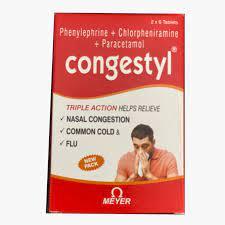PARACETAMOL + CHLORPHENIRAMINE MALEATE + PHENYLEPHRINE
Paracetamol: Paracetamol, also known as acetaminophen, is a common over-the-counter medication used to relieve pain and reduce fever. It belongs to the class of drugs known as analgesics and antipyretics.
Mechanism of Action:
The exact mechanism of action of paracetamol is not fully understood. It is believed to work by inhibiting the synthesis of prostaglandins in the central nervous system, which are responsible for pain and fever. This results in pain relief and reduction in body temperature.
Use:
Paracetamol is primarily used to provide temporary relief from mild to moderate pain such as headaches, toothaches, menstrual cramps, muscle aches, and pain associated with common cold or flu. It is also commonly used to reduce fever in various conditions.
Dose:
The recommended dose of paracetamol for adults is usually 500-1000 mg every 4-6 hours, up to a maximum of 4000 mg per day. For children, the dose is based on their weight and age and should be determined by a healthcare professional. It is important to carefully follow the instructions and recommended dose on the label or as prescribed by a healthcare professional.
Side Effects:
Paracetamol is generally considered safe when used as directed. However, like any medication, it can have some potential side effects. Common side effects include nausea, vomiting, stomach pain, rash, and allergic reactions. In rare cases, it may cause liver damage or blood disorders. Exceeding the recommended dose or taking it for extended periods may increase the risk of side effects. It is important to seek immediate medical attention if any severe side effects or allergic reactions occur.
It is worth noting that paracetamol is often found in combination with other drugs, such as in cold and flu medications or prescription painkillers, so it is important to read the labels and avoid exceeding the recommended dose to prevent accidental overdose.
Chlorpheniramine Maleate: Chlorpheniramine Maleate is an antihistamine medication that is used to relieve symptoms of various allergic conditions, such as hay fever, allergic rhinitis, and hives. It is available both over the counter and as a prescription.
The drug works by blocking the action of histamine, a substance produced by the body during an allergic reaction. By inhibiting the binding of histamine to its receptors, Chlorpheniramine helps alleviate symptoms like sneezing, itching, watery eyes, and runny nose.
The standard dose of Chlorpheniramine Maleate for adults is usually 4 mg to 20 mg every 4 to 6 hours, not to exceed 24 mg in a 24-hour period. However, the specific dosage may vary depending on the individual’s age, condition, and other factors. It is recommended to follow the instructions provided by a healthcare professional or the product label.
Some of the common side effects of Chlorpheniramine Maleate include drowsiness, dizziness, dry mouth, blurred vision, constipation, and urinary retention. These side effects are generally mild and temporary, but if they persist or worsen, it is important to consult a healthcare provider.
It is important to note that Chlorpheniramine Maleate can cause drowsiness, so it is advised to avoid activities that require mental alertness, such as driving or operating heavy machinery, until the individual knows how the medication affects them.
Chlorpheniramine Maleate may also interact with other drugs, so it is crucial to inform healthcare providers about all medications, supplements, or herbal products being taken to prevent any potential drug interactions.
As with any medication, it is recommended to consult a healthcare professional before starting Chlorpheniramine Maleate to ensure it is safe and appropriate for the individual’s specific condition.
Phenylephrine: Phenylephrine is a medication that belongs to the class of drugs known as sympathomimetic agents. It is commonly used as a decongestant to relieve nasal congestion caused by allergies, hay fever, and the common cold. It may also be used in certain eye conditions to alleviate redness and itching.
Phenylephrine works by constricting the blood vessels in the nasal passages and eyes. This helps to reduce swelling and inflammation, allowing for easier breathing or clearing of the eyes. It achieves this by selectively targeting alpha-adrenergic receptors in the blood vessels, causing them to narrow.
The dose of phenylephrine depends on the form it is taken in and the age of the patient. For nasal congestion, it is typically administered as a nasal spray or drops with a recommended dose of 2-3 sprays or drops in each nostril every 4 hours, not exceeding 12 sprays or drops in 24 hours. For eye conditions, phenylephrine is usually applied topically as eye drops with a recommended dose of 1-2 drops in the affected eye(s) up to 4 times a day.
Like any medication, phenylephrine can have side effects. Common side effects may include burning or stinging sensations in the nose or eyes, headache, dizziness, nausea, and increased blood pressure. If used excessively or for prolonged periods, phenylephrine can lead to a rebound effect, where congestion worsens after the medication is discontinued. It is important to follow the recommended dosage and consult a healthcare professional if any severe or persistent side effects occur.
Phenylephrine should be used with caution in individuals with certain medical conditions, such as high blood pressure, heart disease, diabetes, thyroid problems, and prostate enlargement. It may also interact with other medications, so it is essential to inform your healthcare provider about all the medications, supplements, or herbal products you are taking before starting phenylephrine.

